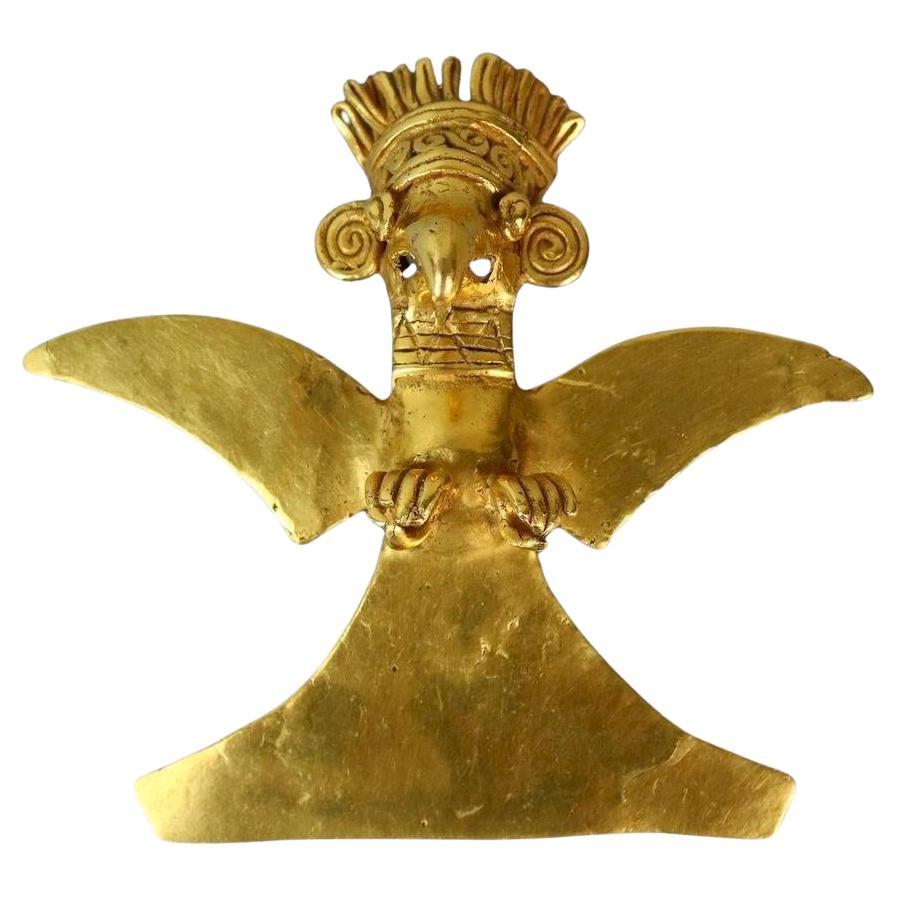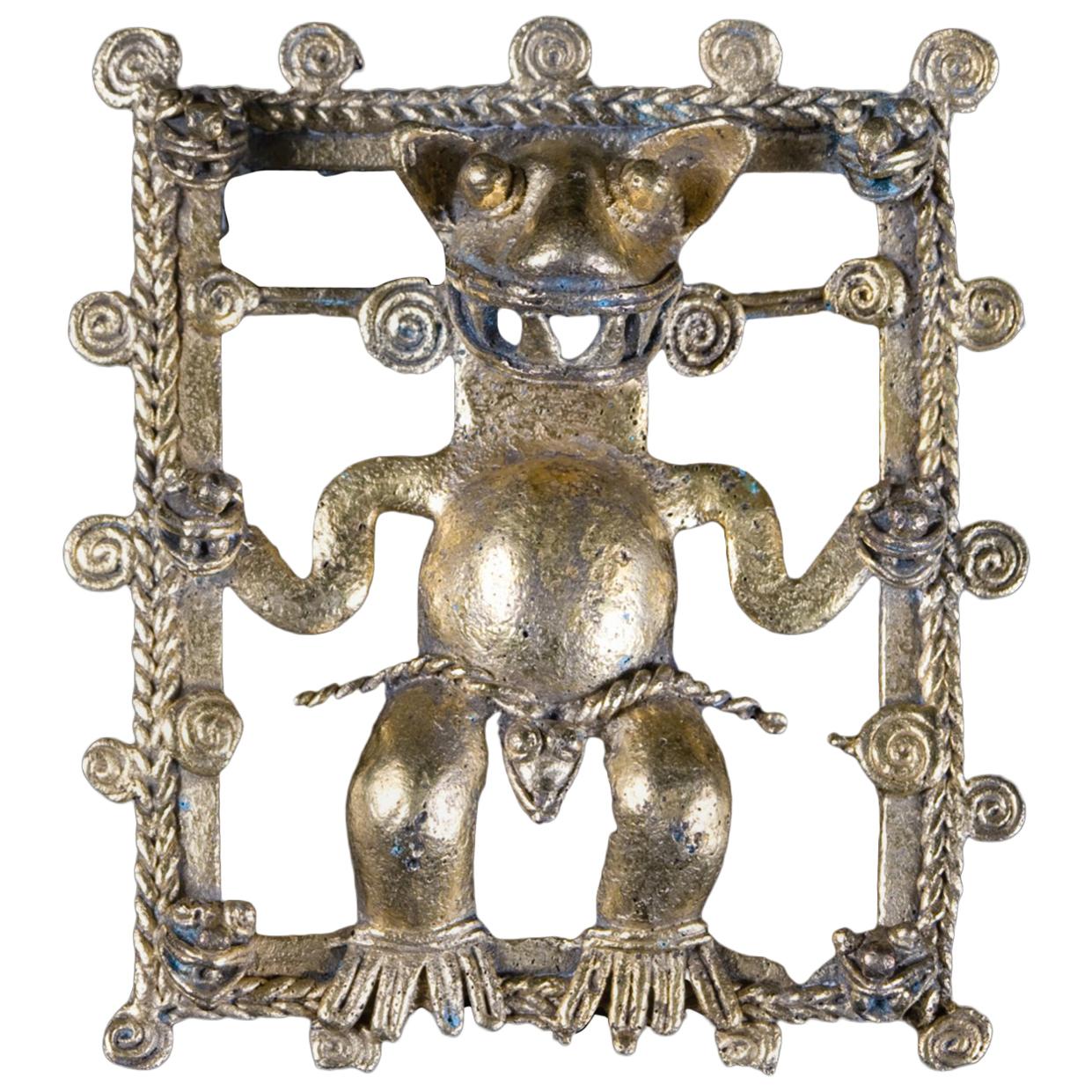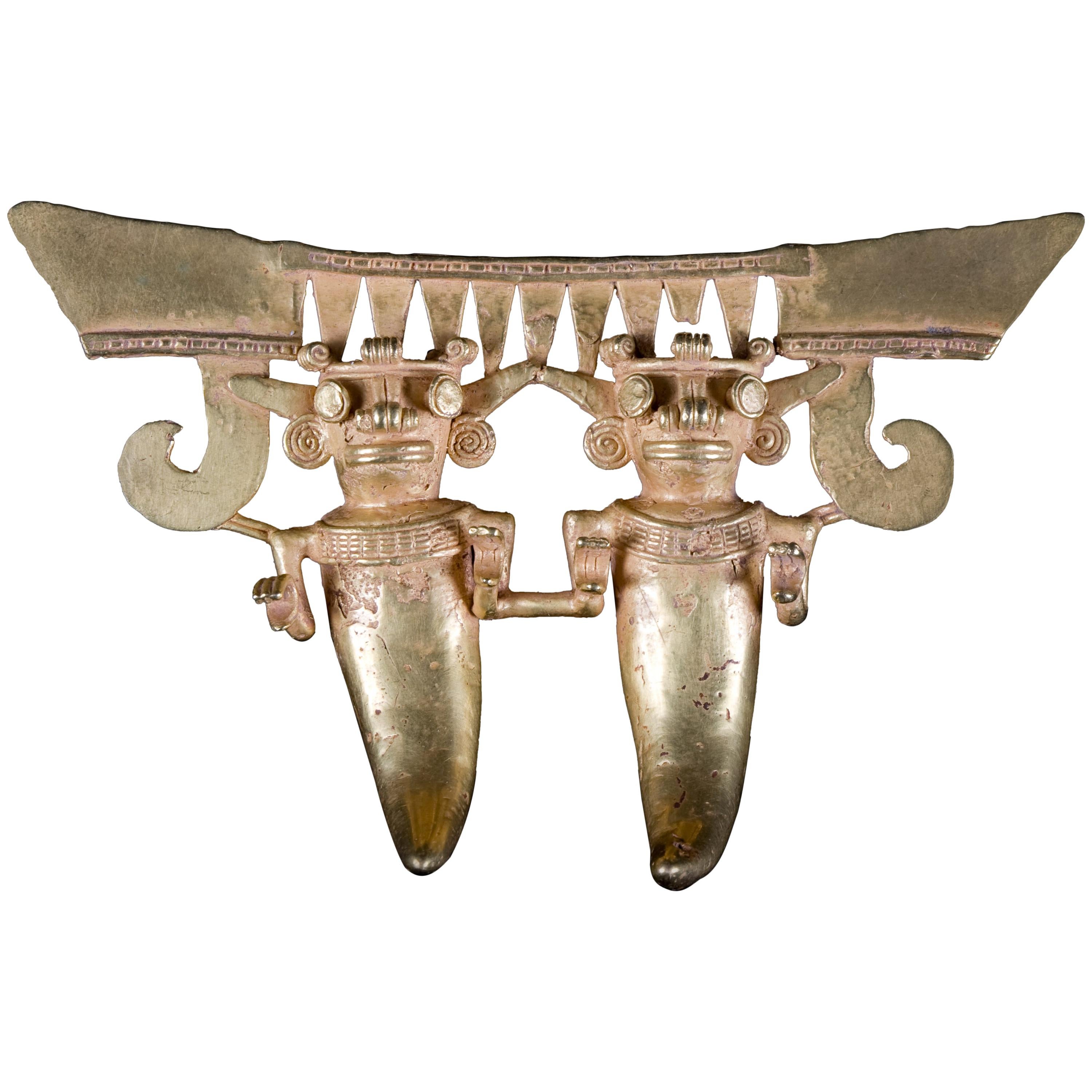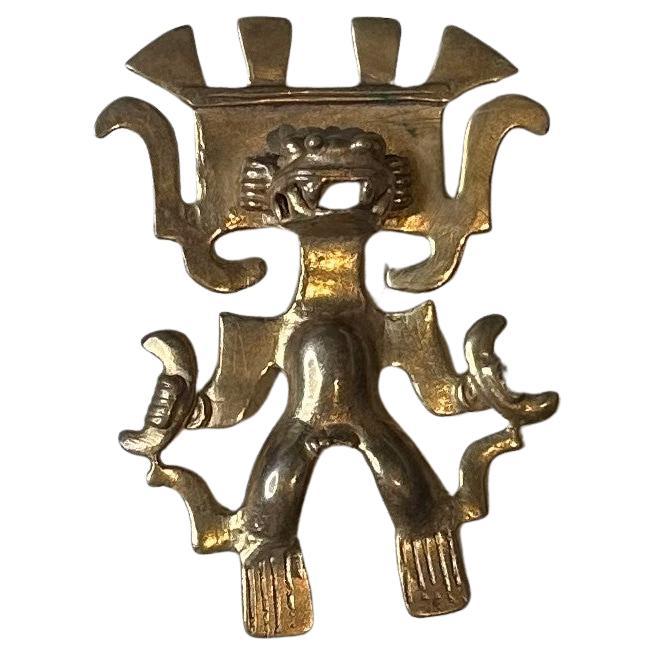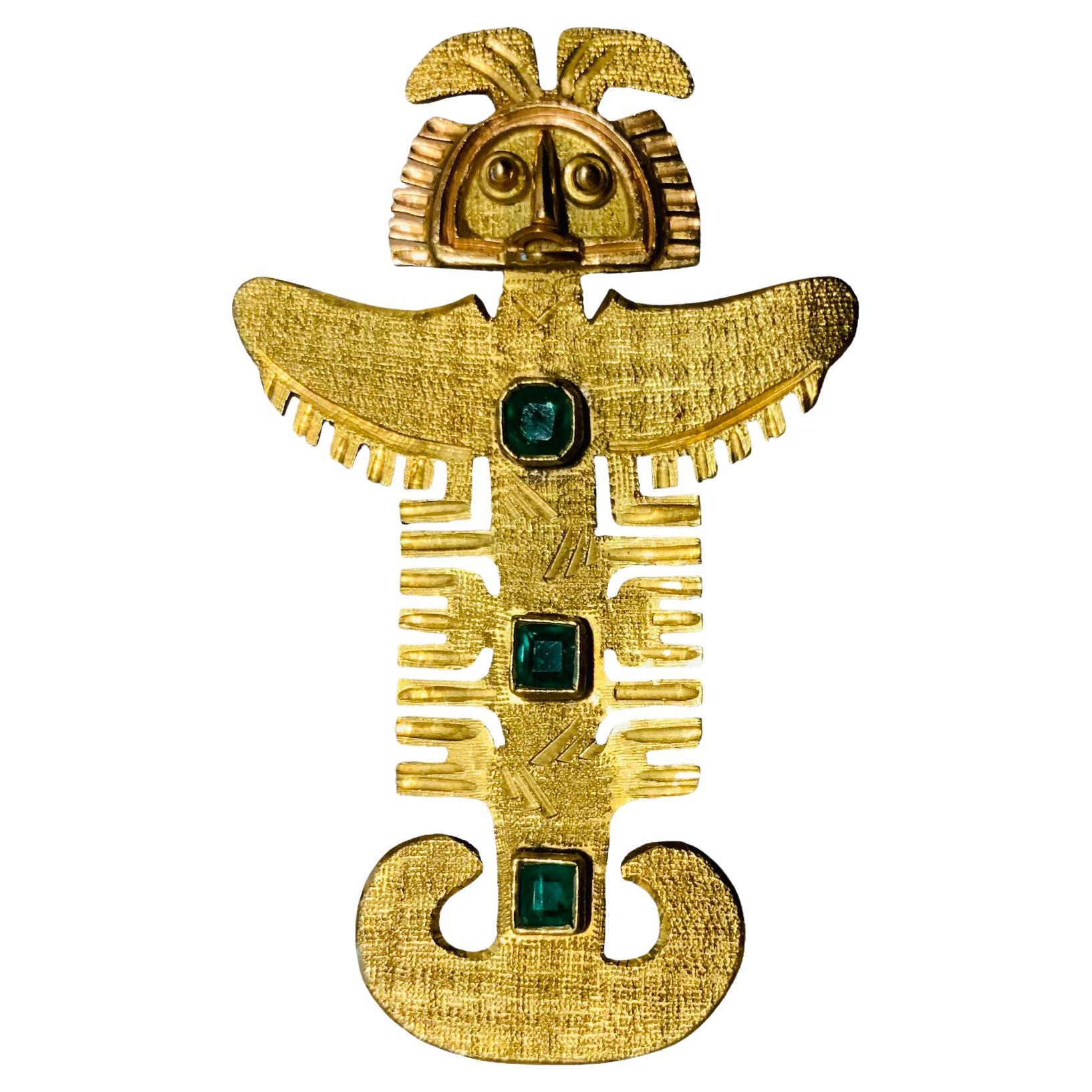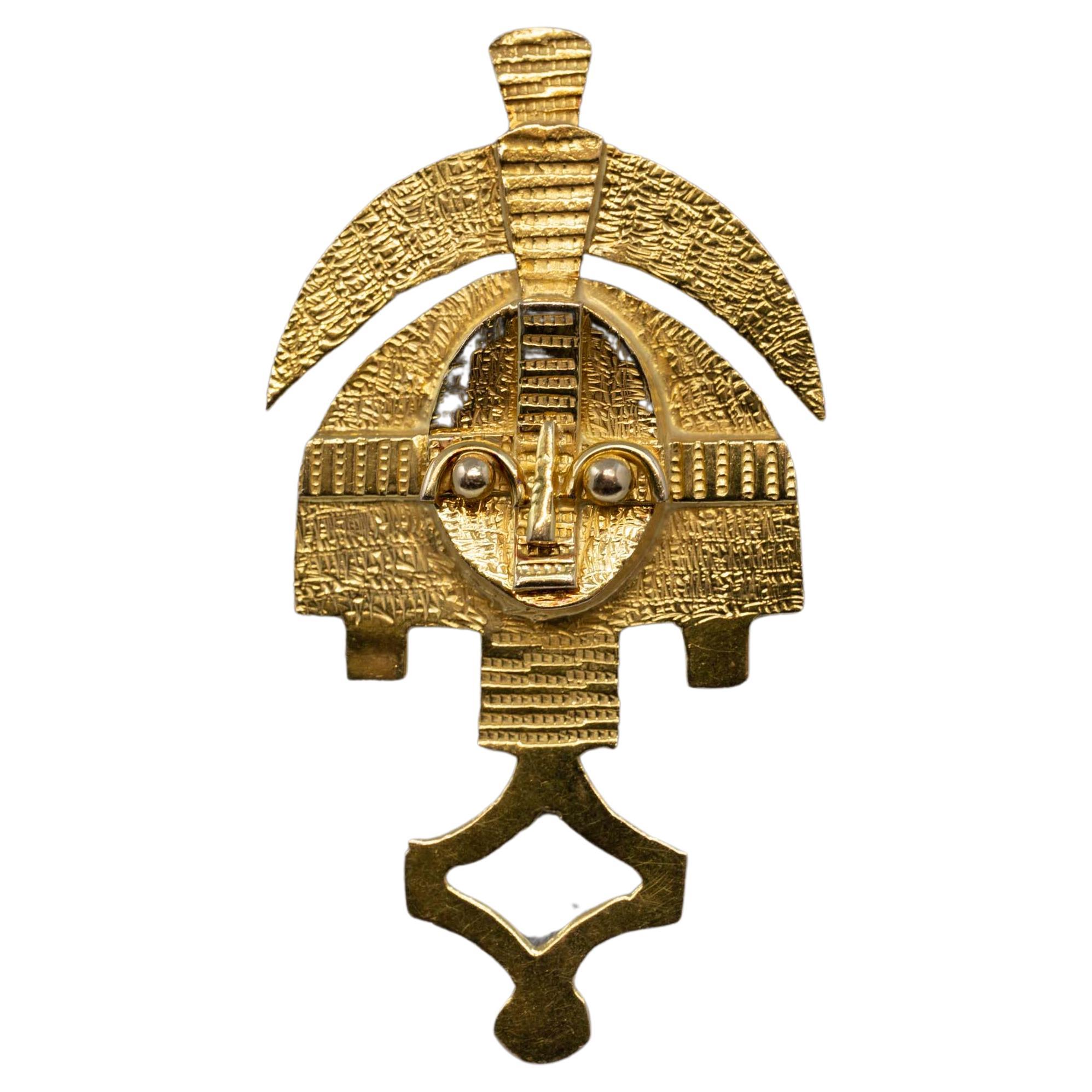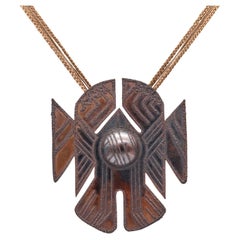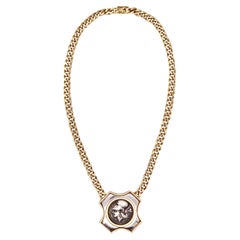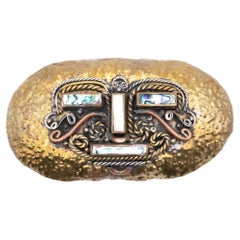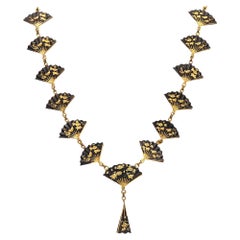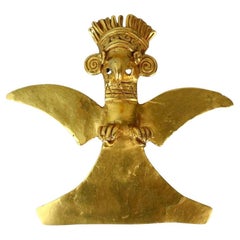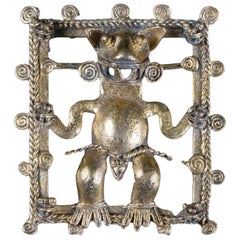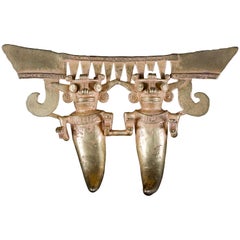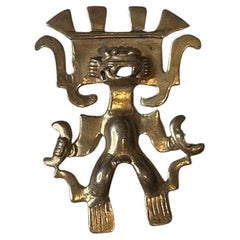Items Similar to Pre Columbian 800 / 1450 AD Costa Rica Chiriki Tumbaga Gold Condor Pendant
Want more images or videos?
Request additional images or videos from the seller
1 of 8
Pre Columbian 800 / 1450 AD Costa Rica Chiriki Tumbaga Gold Condor Pendant
$5,428
$6,78520% Off
£4,121.61
£5,152.0120% Off
€4,713.37
€5,891.7120% Off
CA$7,583.70
CA$9,479.6320% Off
A$8,434.73
A$10,543.4220% Off
CHF 4,404.36
CHF 5,505.4420% Off
MX$102,641.73
MX$128,302.1720% Off
NOK 56,250.34
NOK 70,312.9320% Off
SEK 52,752.90
SEK 65,941.1220% Off
DKK 35,177.67
DKK 43,972.0920% Off
Shipping
Retrieving quote...The 1stDibs Promise:
Authenticity Guarantee,
Money-Back Guarantee,
24-Hour Cancellation
About the Item
Tumbaga gold condor pendant from Costa Rica.
Very rare archeological pre-Columbian piece from the Central American region, between Costa Rica and Panama. Created by the Chiriki culture, between the 800 and 1450 AD and crafted by the wax lost method in the shape of a condor bird with spread wings in solid tumbaga gold. Adapted with a removable piece to be wear as a pendant. This piece do not affect the integrity of the ancient piece.
Weight: 15.95 Grams, (10.22 Dwt).
Measurements: 51 mm by 50 mm by 20 mm (2.0 x 1.97 x 0.79 Inches).
Hallmarks Electronically tested for gold.
Chiriki Culture
The Veraguas culture, also known as the Chiriqui culture, was a pre-Columbian Panamanian culture. It is noted for the quality of its goldwork. The Veraguas culture cast zoomorphic pendants out of gold and tumbaga, using the lost wax method. When using tumbaga, artists would often use acid to remove copper from the surface, allowing for a shinier piece. This process is known as depletion gilding. This goldwork was practiced until the early 16th century AD. The Veraguas culture also produced painted tripod bowls and anthropomorphic figures.In addition, sculptures were made out of basalt.
Tumbaga Gold
The term tumbaga was used in pre-Columbian times from Mesoamerica to Peru and Chile as a generic term for any combination of gold and copper. Tumbaga is an alloy of gold and copper (and sometimes silver). It ranged in content from 3-97% copper with a balance of gold and several trace metals as impurities; silver could be an impurity or a deliberate alloying element up to 18%. One of the reasons that the composition varies so widely is that it was also the name of the metal bars that were hastily produced from South American raw materials during the early years of European conquest and settlement. These bars were shipped back to Spain and separated back into pure copper, gold, and silver. The Pre-Hispanic American metal smiths used tumbaga extensively. Alloying gold with 15-40% copper gives a metal that melts at 860°C (1580°F). The alloy is significantly harder than copper, but is malleable like gold and can be hammered. It is therefore ideally suited to the formation of elaborate objects made of hammered sheet metal. Its relatively low melting point was a big advantage to early metal workers. The alloy could be made to look like pure gold by treating the finished face with an acid solution to dissolve the copper and then hammering or polishing to join the gold, creating a uniform gold surface.
Collateral: This rare piece is accompanied by a presentation jewelry box.
Condition: The overall condition of this piece is excellent. Beside the little normal wear, there is no damage to the gold. This pendant has been carefully inspected to guarantee the condition and the authenticity.
INVENTORY REF: P061723ANNM/.3834
- Creator:Chiriki Culture Tumbaga Gold
- Metal:
- Weight:15.95 g
- Dimensions:Width: 1.97 in (50.04 mm)Depth: 0.79 in (20.07 mm)Length: 207 in (5,257.8 mm)
- Style:
- Place of Origin:Costa Rica
- Period:
- Date of Manufacture:800-1400 AD
- Condition:Wear consistent with age and use. The overall condition of this piece is excellent. Beside the little normal wear, there is no damage to the gold. This pendant has been carefully inspected to guarantee the condition and the authenticity.
- Seller Location:Miami, FL
- Reference Number:Seller: P061723ANNM/.38341stDibs: LU2690219601252
About the Seller
5.0
Recognized Seller
These prestigious sellers are industry leaders and represent the highest echelon for item quality and design.
Platinum Seller
Premium sellers with a 4.7+ rating and 24-hour response times
Established in 1995
1stDibs seller since 2022
915 sales on 1stDibs
Typical response time: <1 hour
- ShippingRetrieving quote...Shipping from: Miami, FL
- Return Policy
Authenticity Guarantee
In the unlikely event there’s an issue with an item’s authenticity, contact us within 1 year for a full refund. DetailsMoney-Back Guarantee
If your item is not as described, is damaged in transit, or does not arrive, contact us within 7 days for a full refund. Details24-Hour Cancellation
You have a 24-hour grace period in which to reconsider your purchase, with no questions asked.Vetted Professional Sellers
Our world-class sellers must adhere to strict standards for service and quality, maintaining the integrity of our listings.Price-Match Guarantee
If you find that a seller listed the same item for a lower price elsewhere, we’ll match it.Trusted Global Delivery
Our best-in-class carrier network provides specialized shipping options worldwide, including custom delivery.More From This Seller
View AllThomas Gentille 1970 Rare Sculptural Ethnics Necklace In Copper And Cotton
Located in Miami, FL
Rare Necklace designed by Thomas Gentille (1936-).
An impressive sculptural piece of art, created in New York city by the artist studio goldsmith Thom...
Category
Vintage 1970s American Modernist Drop Necklaces
Materials
Silver, Copper
Ancient Greek 350 BC Corinth Pegasus Stater Coin Necklace in 18Kt Yellow Gold
Located in Miami, FL
Coin Necklace with Pegasus Stater from Corinth.
A modernist piece, created in Italy and mounted with an authentic silver Stater 350-330 BC, from the ancient Greek city of Corinth. The main frame is custom made in the shape of a Corinthian war shield, crafted in solid 18 karats of white and yellow gold. This frame is attached to a Cuban link chain of 6 mm suited with a push boxed lock and a hinged figure 8 for extra security.
Has a total weight of 52.4 Grams and a lenght of 14.25 Inches (36.2 Cm). Just the main frame element has a measures of 35 mm by 35 mm (1.38 Inches).
Stamped, with the gold assay hallmark, "18 kt".
Coin Obverse description: Portrait bust of Athena facing to the left, with Corinthian war helmet...
Category
Antique 15th Century and Earlier Greek Classical Greek Pendant Necklaces
Materials
18k Gold, White Gold, Yellow Gold
$5,580 Sale Price
20% Off
Free Shipping
Casa De Maya Mexico 1950 Mid Century Sculptural Retro Belt Buckle Pendant
Located in Miami, FL
Statement belt-buckle pendant designed by Casa De Maya.
A rare vintage piece, created in Mexico during the mid-century back in the 1950. Crafted at the at...
Category
Vintage 1950s Mexican Modernist Pendant Necklaces
Materials
Brass, Copper, Mixed Metal
$468 Sale Price
20% Off
Free Shipping
JAPAN 1910 Meiji Menuki Necklace With Shakudo In 14Kt Gold 24Kt Gold & Bronze
Located in Miami, FL
Exceptional Shakudo necklace with Japanese Menuki.
This is a fabulous one of a kind Shakudo necklace created in Japan during the Meiji period, back in 1910. The necklace has been crafted in solid yellow gold of 14 karats with brushed finish, chiseled 24kt gold and blackened patinated bronze (niiro). The twenty decorative fan-shaped elements are genuine Japanese Menuki depicting organic motifs, such; birds, trees, plants and leaves. The menukis are original parts, all of them recovered from genuine antique Japanese sword...
Category
Vintage 1910s Japanese Arts and Crafts Pendant Necklaces
Materials
Gold, Yellow Gold, Bronze, 14k Gold, 24k Gold, Shakudo
$4,798 Sale Price
20% Off
Free Shipping
Tiffany & Co. 1979 by Angela Cummings Petals Necklace in 18Kt Yellow Gold
By Tiffany & Co.
Located in Miami, FL
Necklace of petals designed by Angela Cummings.
Beautiful necklace, created by Angela Cummings for the Tiffany Studios in New York city, back in the 1979. This iconic and unique nec...
Category
Vintage 1970s American Modernist Pendant Necklaces
Materials
Gold, 18k Gold, Yellow Gold
$15,160 Sale Price
20% Off
Free Shipping
GUBELIN 1970 Grand Canyon Fractured Pendant In Solid 18Kt Yellow Gold
By Gubelin Lucerne
Located in Miami, FL
Modernist Grand Canyon pendant designed by Gubelin.
Fabulous movable pendant, created during the modernism period back in the 1970. This sculptural p...
Category
Vintage 1970s Swiss Modernist Pendant Necklaces
Materials
Gold, Yellow Gold, 18k Gold
$6,760 Sale Price
20% Off
Free Shipping
You May Also Like
24K Gold Pre Colombia Eagle Pendant
Located in Flushing, NY
24K Gold Pre Colombia Eagle Pendant
Approximate Dimensions:
2.8 inches (Length)
3.1 inches (Width)
40.2 gram in Weight.
Category
Antique 15th Century and Earlier Pendant Necklaces
Supernatural Being, Pre-Columbian Gold Pendant, Costa Rica, circa 800 to 1500 AD
Located in San Pedro Garza Garcia, Nuevo Leon
Southern Costa Rica or Western Panama, circa 800 to 1500 AD. A very fine example of the goldwork of the Veraguas-Chiriqui-Diquis region. A pendant in Carbonera style of a supernatural being, a composite monster with human torso and feline (probably jaguar) head. The figure is set in a frame decorated with little animal heads, one at each corner. The hands have also turned into animal heads. In place of genitalia is a stylized serpent head suspended by a twisted cord that was supposed to continue across the frame. A minor casting accident prevented it form being attached to the frame. A modern goldsmith would solder in two short lengths of twisted wire, but the ancient goldsmith did not have the equipment to make such repair. A double thread ending in spirals goes across the frame behind the neck of the figure, helping to fill up the frame and avoiding a large empty space. The word "thread" reminds us that the twisted and straight cords were, in the original wax model of the pendant really extruded wax threads, turned into metal by the lost wax (cire perdue) process. The braid pattern on the frame is illusory, just two twisted threads of extruded wax laid side by side. The goldsmith made the toes out of extruded wax thread too, very decorative as well. The piece comes with a certificate of authenticity by Mr. Robert Sonin, 5 May 2006. ref. photo roll 3301. A world renowned expert on Pre-Columbian Artifacts...
Category
Antique 15th Century and Earlier Costa Rican Pre-Columbian Figurative Sc...
Materials
Gold
Museum Quality Pre-Columbian Gold Twin Figures Pendant, circa 800 to 1500 AD
Located in San Pedro Garza Garcia, Nuevo Leon
Southern Costa Rica/Western Panama, circa 800 to 1500 AD. Gold Veraguas-Chiriqui-Diquis twin figure pendant cast by the lost-wax (cire perdu) grasping an imaginary club with their claws, with bat ears and pop out eyes and each figure ending in the shape of a jaguar tooth, symbolizing the power of the jaguar and the ability to see in the dark; The casting process did not go entirely smoothly. Part of his mold, on the side of the proper right figure (viewer's left side), did not fill with metal. The Pre-Columbian goldsmith carried out a superb repair, probably making a wax patch and pouring gate on the gold pendant, then enclosing it in a new mold and pouring in more metal. The patch is hardly visible on the outside. A modern goldsmith, who cannot do it as well, would use his gas torch to solder on a patch. The gold is of such high grade or karat, possibly unalloyed native gold...
Category
Antique 15th Century and Earlier Costa Rican Pre-Columbian Figurative Sc...
Materials
Gold
Vintage Gold Tribal Pendant
Located in West Palm Beach, FL
A Vintage Gold Tribal Pendant is a captivating piece of jewelry that combines rich history, cultural symbolism, and timeless craftsmanship. Tribal-inspired jewelry has always been as...
Category
Late 20th Century Regency Pendant Necklaces
Materials
Gold Plate
Pre-Columbian Art 18k Yellow Gold And Emerald Brooch/Pendant
Located in Guaynabo, PR
This is an 18K Yellow gold and Emerald hand crafted Pre-Columbian large brooch/pendant. It depicts a Central America Native God adorned in the ...
Category
20th Century Central American Artisan Brooches
Materials
Emerald, 18k Gold, Yellow Gold
Aztec 18k Gold God Pendant
Located in Montreal, QC
Stamped with an illegible mark tested 18k. Measures 2 1/8 inches long x 1 1/8 inches wide, weight 12.5 grams. Circa 1980.
Category
Vintage 1980s Unknown Brooches
Materials
18k Gold
More Ways To Browse
Peru Gold
Peruvian Gold
Columbian Gold Jewelry
Antique Bird Necklace
Pre Columbian Jewelry
South Jewellery Antique Necklace
Antique Copper Necklace
15c Necklace
Gold Peru Necklace
Pre Columbian Box
Peruvian Silver And Gold Jewelry
Antique Costa Rica
Hammered Copper Jewelry
Uniform Object Jewelry
Gold Tumbaga
Vintage 18k Zodiac
14k Emerald Sapphire Ruby Necklace
Aquamarine Cabochon Pendant
